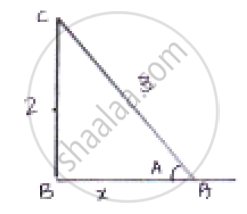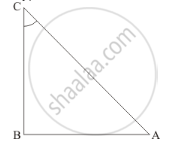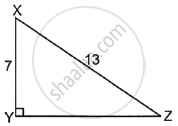Advertisements
Advertisements
प्रश्न
In the following, trigonometric ratios are given. Find the values of the other trigonometric ratios.
`sin A = 2/3`
उत्तर १
We know that `sin theta = "opposite side"/"hypotenuse"`
Let us Consider a right-angled ΔABC

By applying Pythagorean theorem we get
𝐴𝐶2 = 𝐴𝐵2 + 𝐵𝐶2
`9 = x^2 + 4`
`x = sqrt5`
We know that = `cos = "adjacent side"/"hypotenuse"` and
`tan theta = "opposite side"/"adjacent side"`
So `cos theta = sqrt5/3`
`sec = 1/cos theta = 3/sqrt5`
`tan theta = 2/sqrt5`
`cot = 1/tan theta = sqrt5/2`
`cosec theta = 1/ sin theta = 3/2`
उत्तर २
Given: sin` A=2/3`……(1)
By definition
`sin A= "perpendicular"/"Hypotenuse"` …... (2)
By Comparing (1) and (2)
We get,
Perpendicular side = 2 and
Hypotenuse = 3

Therefore, by Pythagoras theorem,
`AC^2=AB^2+BC^2`
Now we substitute the value of perpendicular side (BC) and hypotenuse (AC) and get the base side (AB)
Therefore,
`3^2=AB^2+2^2`
`AB^2=3^2-2^2`
`AB^2=9-4`
`AB^2=5`
`AB=sqrt5`
Hence, Base = `sqrt5`
Now, `Cos A=" Base"/ "Hypotenuse"`
Cos A=` sqrt 5/3`
Now, `Sec 4= "Hypotenuse"/"Perpendicluar"`
Therefore,
`"Cosec" A= "Hypotenuse"/"Perpendicular"`
`"Cosec" A=3/2`
Now, `tan A="Perpendicular"/"Base"`
Therefore,
`Sec A=3/sqrt5`
Now, `tan A "Perpendicular"/"Base"`
Therefore,
`tan A= 2/sqrt5`
Now,`Cos A= "Base"/"Perendicluar"`
Therefore,
`Cot A= sqrt 5/2`
APPEARS IN
संबंधित प्रश्न
In Given Figure, find tan P – cot R.

If 4 tan θ = 3, evaluate `((4sin theta - cos theta + 1)/(4sin theta + cos theta - 1))`
Evaluate the Following
cosec3 30° cos 60° tan3 45° sin2 90° sec2 45° cot 30°
Find the value of x in the following :
cos 2x = cos 60° cos 30° + sin 60° sin 30°
If cos (40° + A) = sin 30°, then value of A is ______.
Prove the following:
If tan A = `3/4`, then sinA cosA = `12/25`
The value of the expression (sin 80° – cos 80°) is negative.
Prove that sec θ + tan θ = `cos θ/(1 - sin θ)`.
Proof: L.H.S. = sec θ + tan θ
= `1/square + square/square`
= `square/square` ......`(∵ sec θ = 1/square, tan θ = square/square)`
= `((1 + sin θ) square)/(cos θ square)` ......[Multiplying `square` with the numerator and denominator]
= `(1^2 - square)/(cos θ square)`
= `square/(cos θ square)`
= `cos θ/(1 - sin θ)` = R.H.S.
∴ L.H.S. = R.H.S.
∴ sec θ + tan θ = `cos θ/(1 - sin θ)`
In the given figure, if sin θ = `7/13`, which angle will be θ?

If θ is an acute angle and sin θ = cos θ, find the value of tan2 θ + cot2 θ – 2.
